About this work
This works addresses the problem of automatic image colorization using deep learning techniques. We explore a way of generating colored images from grayscale images with some degree of spatial control, so we could get partial colored images with an artistic effect if desired.
This project was developed as a conclusion work for the course Fundamentals and Trends in Vision and Image Processing (August-November, 2018) at IMPA, which had the theme from Data to Generative Models.
Inspirations
There are multiple works about colorization with many different results to be pursued. We can think of automatic photorealistic colorization, color correction, color transfer between images, quantization, tone mapping, colorization from grayscale or recolonization restricted to some criteria like a specific color palette or specific degrees of some metric like saturation, constrast, brightness etc. In this section we’ll present some ideas and related works that were used as technical references at this work or inspired us in some way.
Artistic neural style transfer
One of the most impressive and deeply used results to disseminate the advances reached in the area is artistic style transfer. Not only it generates beautiful and astonishing images but also It is something of ease access for someone who is a layperson on the subject. When we show people images like those in Figure 1, they can easily understand the relationship between them and usually ask the question: “did a computer do that?”.
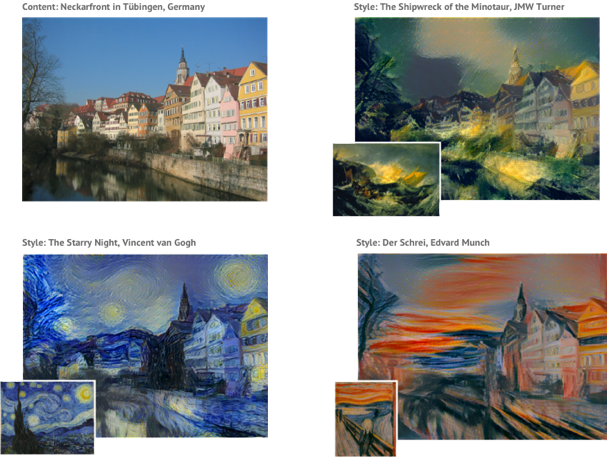
The work of (Gatys, 2016) addresses artistic style transfer using neural networks as a patterns recognizer and an optimization tool, presenting the features that should be computed and used from the layers of the neural network. The paper also describes how to compute an objetive function, or loss function, using these features. We didn’t want to try to extend the results on artistic style transfer, but we did want to achieve something that could be used in an artistic way. This application could be either by generating new images directly or by acting as a tool to facilitate artist’s work.
Classical works
Following the ideia of style transfer, one could think about a “color transfer” or “recoloring tool”, which could be thought as a a way of transposing the colors of a source image or a selected palette to a target image. Many years ago, Reinhard (Reinhard, 2001) presented a color transfer algorithm based on statistical metrics as the mean and the standard deviation of the values in each channel of the image — looking at the LAB space.
In a first moment this approach seemed particularly interesting for us, because machine learning deals heavily with statistics. Trying to figure out a way of training a neural network to manipulate this metrics and generate images with a desired property could be an interesting work. However, once we have metrics like mean, standard deviation or even the histogram of colors of an image, we lose the correlation with spatial information and it’s not clear how we could deal with it in the context of neural networks.

On the other hand, acting with spatial information, Levin (Levin, 2004) presented a way of coloring a grayscale a image using some inputs of the user as hints. They present a closed form solution to an optimization problem based on the hypothesis that nearby pixels with similar luminance values should have similar chrominance values. The ideia behind this paper could help building an interesting tool for assisted colorization.

Note that none of these works deals with neural networks, but since they are based on optimization techniques and statistical metrics of the images, it is reasonable to suppose that it’s possible to construct and train neural networks capable of reproducing similar results. We didn’t follow this path though.
Neural networks and colorization
When we search for image colorization in the context of deep learning we can find a variety of works interested in make a computer guess the colors of a grayscale image making it a photorealistic colored scene. Based only on the value of luminance and some spatial information, we have largely degrees of freedom in the task of computing color information, which makes the problem ill-posed.
Researching about colorization with neural networks, we identified basically 3 strategies to solve the problem. The first one consists of trying to modify the input image extrapolating (or extending) the concept of backpropagation; one can think of this as if we used the inputs to the network as a hidden layer and updated the values with back-propagation. The second ideia is to try to estimate a color for each pixel of the image, something similar to a regression – that’s the approach at (Zhang, 2016) for example. The last strategy is the use of Generative Adversarial Networks.
Goal
With the idea of making something with a potential artistic style and some knowledge about the solutions which addressed some problems in the colorization area, we decided to make colorization with some degree of spatial control. We would like to build a way to get partial colorization of images and achieve artistic results like those presented in figure 4.
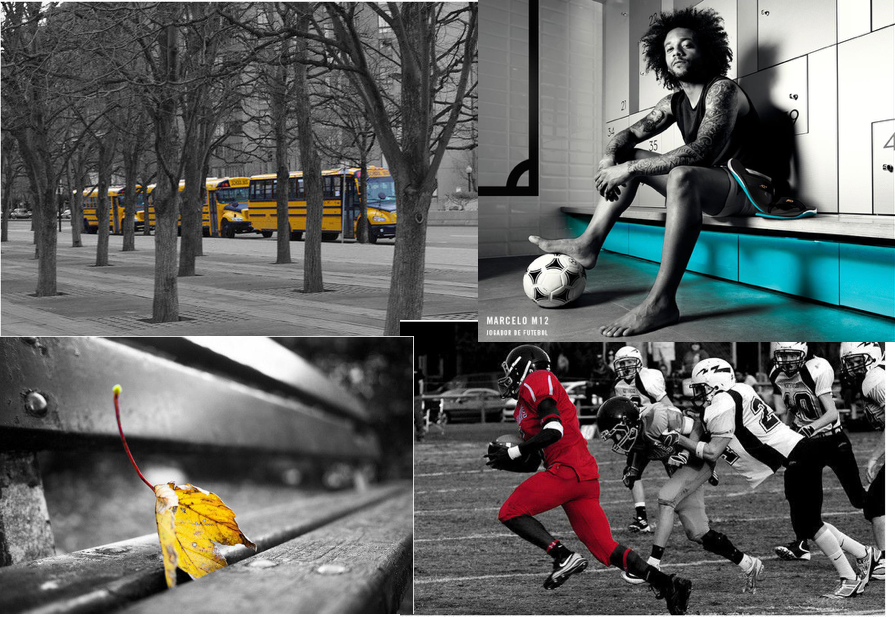
Our approach
After studying many projects about colorization with deep learning, we decided to approach the problem using Generative Adversarial Networks (GANs). We found some very good results in other works which didn’t use GANs, particularly (Zhang, 2016) and (Luan, 2018). The former doesn’t address the colorization problem specifically, but the ideas developed to harmonize the style and colors of images pasted into a painting could be useful. The problem is we didn’t figure out a simple way to experiment spatial control in the architectures of networks presented in these works. Besides that, these works had some delicate steps which could need more time to do correctly than we could provide for the project.
The network
We based our solution on the code available in 3 different repositories on the Github. We started studying the code at (Zaneri, 2018), which has a detailed paper explaining the results, but we decided to start most of our solution from the network model available at (Han, 2018) and the software architecture available at (Zhao, 2018) because they were written in Pytorch – the framework we were most comfortable to work. The generator architecture is composed of 11 layers with an encoding structure followed by a decoding one, with skipping connections between layers symmetrically disposed. This direct connections between non sequential layers (skipping) are necessary to keep spatial information in the final layers.
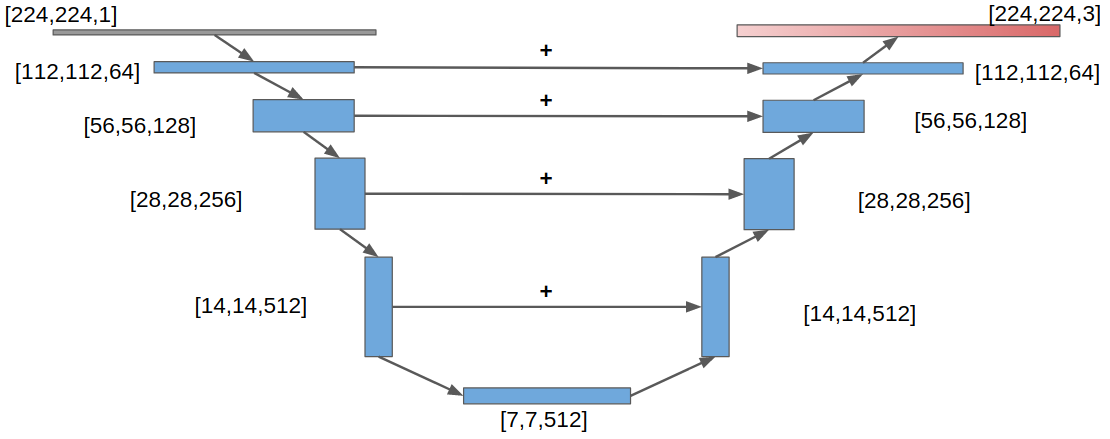
We read some works where the discriminator network was trained using some pre-trained network as baseline, for example VGG-16. In (Zaneri, 2018) they built their own model for the discriminator and we chose to use this model which has an architecture that resembles that of the generator, but only the encoding side, leading to an output of the probability that the image taken from the generator is classified as a fake.
The masks
To incorporate spatial control in the colorization made using GANs, we tried to follow the ideia of Conditional GANs (Mirza, 2014), changing the generator network to receive as input not only a grayscale image but also a binary image which would act as a mask. The discriminator network was also modified to receive the same mask in addition to the colored image. In both cases the mask ended up concatenated as another channel of the other image. The last change we had to do was to add a term to the total loss function, a mask loss, penalizing the distance between the generated colors and the desired colors with the squared L2 norm. With this approach we expected to teach the network to color only the regions where the pixels had a non-zero value.
As we weren’t sure if this approach would prove itself promising, we tested our hypothesis over the 17 Categories Flower Dataset, training the networks using 1360 images with a single synthetic mask, an image divided vertically. We expected the network to learn how to generate images half in color and half in grayscale. Unfortunately, this didn’t work, as the network began to generate images completely colored, but with a very visible line where it was the hard division of the mask (figure 7). Before training the modified network with masks, we trained the original networks using only the images from our selected dataset to check if it was enough to make the network learn how to color the flowers. The colorization obtained was “fine”, with a bias to the yellow color. The network identified the flowers and usually painted them with a yellow color, but the leaves, the sky and other elements were painted reasonably.
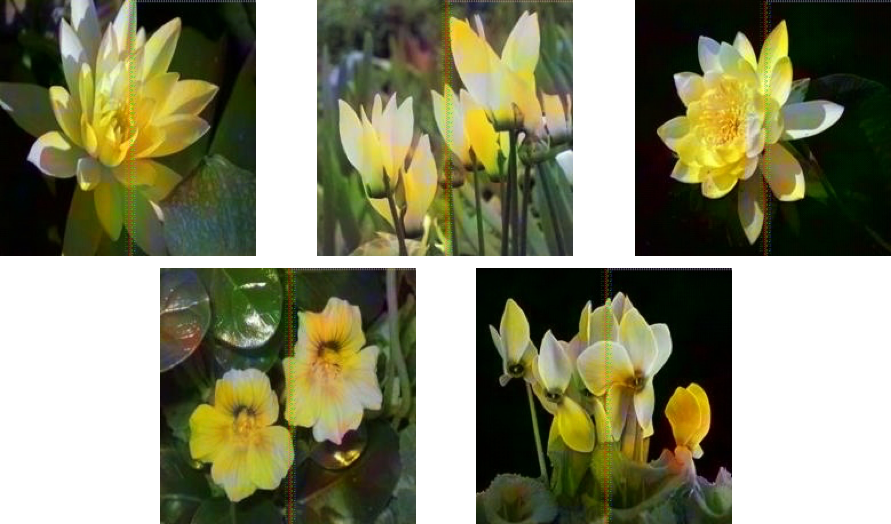
Although the results of this experiment weren’t encouraging, we decided to try again using a set of masks (figure 8), instead of a single one. We made 10 synthetic masks using stripes and grids in a graphic editor software and trained the network again (starting from random weights). This time we got results near to that we were expecting, as we show in figures 9, 10 and 11.
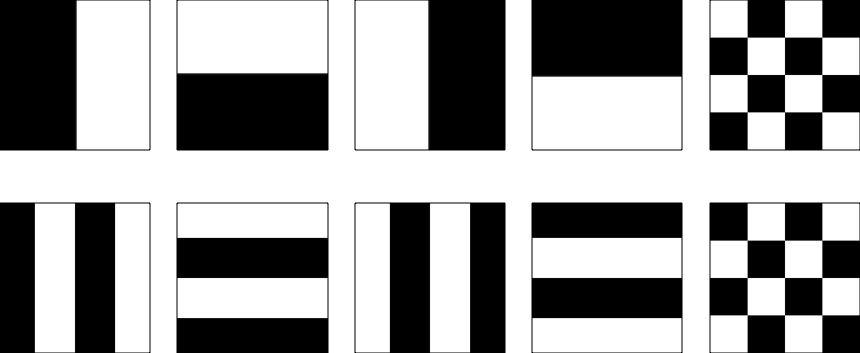



Considerations
We trained the GANs for 80 epochs combining each image with all masks during the training. We used Google’s Colaboratory environment to train the networks powered by a GPU with support to Nvidia’s CUDA.
Looking to the results shown in the figures 9 to 11, we can see that the generated images were painted accordingly to the synthetic masks used. At this point, however, we can’t guarantee that this pattern would be replicated with other types of masks. It’s necessary to train the network with many masks of different kinds such as synthetic masks unrelated to the images, segmentation masks of the contents of the images, noisy masks and random sampled masks, to give some examples. Nevertheless, we find the results got so far very promising as they give us a direction to investigate.
Another relevant aspect to notice is that we trained the network over a very small dataset. Before trying to use a huge dataset, we consider doing more exploratory experiments such as small changes to our loss function. Instead of a squared loss, we could experiment to train the networks with a Huber loss, so it could be less sensitive to some variation. We can also keep trying new values for the weight that multiplies the mask loss.
Next Steps
The results achieved with this project suggests us that research on the use of GANs conditioned to binary masks is a promising direction. Due to the nature of these first experiments, we can’t draw a definitive conclusion yet. We conducted experiments with synthetic masks that were unrelated to the contents of the images — the masks had very specific patterns. We think it’s necessary to train the network using a wide variety of masks, so: synthetic masks unrelated to the images, segmentation masks of the contents of the images, noisy masks and random masks to give some examples.
After these experiments we’ll have enough information to draw robust conclusions about this proposal. It’s important to have in mind that it might be necessary to also change the networks architectures to increase its capacity, possibly making it deeper.
. Another significant change we could make is to train the networks with a bigger and more diverse dataset. At first, we think it’s possible to proceed with the 112 Category Flower Dataset. Having success with the previous steps and thinking about a tool for artist’s to use, we could integrate an image segmentation module (neural network) to the pipeline of the network and allow the user to control which objects or which parts of an object should be colored.
References
- Gatys, Leon A., Alexander S. Ecker and Matthias Bethge. “Image Style Transfer Using Convolutional Neural Networks.” 2016 IEEE Conference on Computer Vision and Pattern Recognition (CVPR) (2016): 2414-2423.
- Erik Reinhard , Michael Ashikhmin , Bruce Gooch , Peter Shirley, Color Transfer between Images, IEEE Computer Graphics and Applications, v.21 n.5, p.34-41, September 2001 [doi>10.1109/38.946629]
- Levin, Anat, Dani Lischinski and Yair Weiss. “Colorization using optimization.” SIGGRAPH ‘04 (2004).
- Luan, Fujun, Sylvain Paris, Eli Shechtman and Kavita Bala. “Deep Painterly Harmonization.” Comput. Graph. Forum 37 (2018): 95-106.
- Nilsback, M-E. and Zisserman, A. A Visual Vocabulary for Flower Classification. Proceedings of the IEEE Conference on Computer Vision and Pattern Recognition (2006) http://www.robots.ox.ac.uk/~vgg/publications/papers/nilsback06 {pdf,ps.gz}
- Nilsback, M-E. and Zisserman, A. Automated flower classification over a large number of classes. Proceedings of the Indian Conference on Computer Vision, Graphics and Image Processing (2008) http://www.robots.ox.ac.uk/~vgg/publications/papers/nilsback08.{pdf,ps.gz}.
- Zhang, Richard and Isola, Phillip and Efros, Alexei A . Colorful Image Colorization. ECCV 2016
- Nazeri, Kamyar and Ng, Eric and Ebrahimi, Mehran. Image Colorization Using Generative Adversarial Networks International Conference on Articulated Motion and Deformable Objects p. 85–94. 2018.
- Paul Andrew. 50 Wonderful Black & White Photos with Partial Color Effects. Specky Boy website, 2016. Last access at December, 19, 2018.
- Advertisement campaign of Kenner’s M12 sandals. Kenner Brazil website, 2018. Last access at December, 19, 2018
- Han, Tenda. Image Colorization using GANs. Github repository and Technical report, Australia National university, 2017. Last Access at December, 20, 2018.
- Zhao, Jeffery. Neural Colorization. Github repository. Last access at December, 20, 2018.
- Mirza, Mehdi and Simon Osindero. “Conditional Generative Adversarial Nets.” _CoRR_abs/1411.1784 (2014): n. pag.
Other materials
Keynote presentation:
You’ll find embedded below the keynote presented on the last class of the course.
Presentation may be updated, in relation to that presented during the course, to fix typos, be more coherent with this website and/or complete references and images.
Source code
The source code for this project is available at this Github repository. The dataset used for training is the 17 Category Flower Dataset.